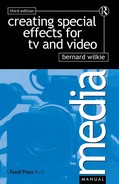Matte and Glass Shots
There are many ways of increasing the area of a scene without building scenery or adding to the amount of floor space. The techniques used not only give additional dimensions, but also permit effects to be obtained that might be impossible in real terms.
Matte shots
These are usually associated with film, the TV equivalent being the electronic inlay and overlay devices for obtaining similar results.
Briefly, a film matte is the process by which part of a frame is left unexposed so that it can later be used to record another picture. In this way two components may be used to produce a single picture on one negative. The simplest example is where a black card is positioned in front of the camera so that only half a picture is recorded. The film is then rewound without moving the position of the camera and the black card is repositioned to obscure the part of the scene that has already been filmed. The composite picture is called a split screen. It permits an actor to appear as two people in the same shot. Matte work is the province of the cameraman and the processing laboratories and involves some very complicated processes. The most versatile is known as travelling matte where backgrounds can be inserted behind actors who have previously played their scene against a coloured backing.
Glass shots
Glass shots are often used where it is required to show a ceiling without actually constructing one. The technique is to set a sheet of glass in front of the camera and for the false ceiling to be painted directly on the glass. This must be done with constant reference to the camera eyepiece to ensure that the painting lines up with the studio set. The size of the painting and its distance from the camera are governed by the fact that both scene and foreground glass must be in focus.
As the sheet of glass reflects anything in front of it, the camera must be in a darkened area or surrounded by black drapes.
Glass is used when particularly fine work or disconnected items have to appear in the scene, but there are many instances when it can be dispensed with and a simple cardboard cut-out employed. This is possible when skies, landscapes or seascapes are included in a scene.
The card, painted to blend with the scenery, can be made to match at some convenient natural boundary – such as the horizon or the ridge of a roof. For a false ceiling for studio scenes the tops of flats on the set and the bottom of a piece of card blend quite satisfactorily.
The glass shot does not always require the work of an artist: cut-out photographs, provided they are big enough, can be used to supplement the scene.
MATTE AND GLASS SHOTS
1. Painted scenery
By using pictures painted on glass much time and money can be saved in construction of scenery. The example shown here demonstrates how the top half of an oil rig is aligned with a scenic base built on location. Reflections in the glass can be troublesome and black boards – or even complete black cabins – must be erected to shield the glass, a, Black sheet, b, Painted glass, c, Scenic base, d, Final picture.
2. Ceilings
The painted glass technique is often used to provide ceilings for interior sets in the studio.

